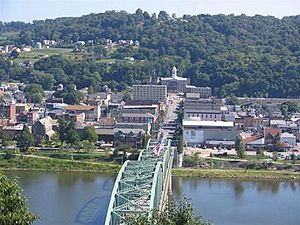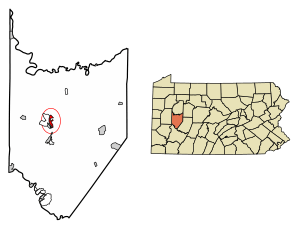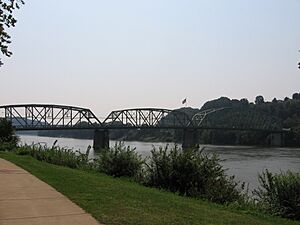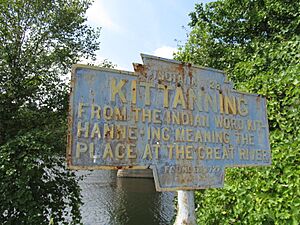Kittanning, Pennsylvania facts for kids
Quick facts for kids
Kittanning
|
|
|---|---|
|
Borough
|
|

The Kittanning Citizens Bridge, Armstrong County Courthouse, and downtown of Kittanning
|
|
| Etymology: Lenape kithanink, 'on the main river' | |

Location of Kittanning in Armstrong County, Pennsylvania.
|
|
| Country | United States |
| State | Pennsylvania |
| County | Armstrong County |
| Settled | 1727 (Native American village) |
| Settled | 1803 (Borough) |
| Area | |
| • Total | 1.25 sq mi (3.24 km2) |
| • Land | 1.00 sq mi (2.58 km2) |
| • Water | 0.25 sq mi (0.66 km2) |
| Population
(2020)
|
|
| • Total | 3,921 |
| • Density | 3,936.75/sq mi (1,519.46/km2) |
| Time zone | UTC−5 (EST) |
| • Summer (DST) | UTC−4 (EDT) |
| ZIP Code |
16201
|
| Area code(s) | 724 |
| FIPS code | 42-40040 |
| School district | Armstrong |
Kittanning (pronounced ki-TAN-ing) is a small town, called a borough, in Pennsylvania, United States. It is the main town, or county seat, of Armstrong County, Pennsylvania. You can find it about 36 miles (58 km) northeast of Pittsburgh. It sits right on the east bank of the Allegheny River. In 2020, about 3,921 people lived there.
The name Kittanning comes from the Lenape language. It means 'on the main river'. The Lenape people thought the Allegheny and Ohio rivers were one big river. Kittanning and its bridge have even been featured in some movies!
Contents
History of Kittanning
Kittanning is built where an old Lenape (Delaware) village used to be. This village was also called Kittanning. It was at the end of the Kittanning Path, which was an old Native American trail.
Early Conflicts and Settlement
In 1756, during the French and Indian War, the village was destroyed. This happened during the Battle of Kittanning. An explosion from a gunpowder storage in Captain Jacobs's house was so loud. It could be heard 44 miles away in Fort Duquesne, which is now Pittsburgh.
After the American Revolutionary War, more European Americans started to settle in Kittanning. It was chosen to be the main town for Armstrong County. Some traders, like Anthony Sadowski, were here even before the war.
Kittanning in the Civil War
During the American Civil War, a group of soldiers was formed in Kittanning. They were part of the 103rd Regiment of Pennsylvania Infantry. They joined the army between September 1861 and February 1862. These soldiers fought in important battles. This included the Siege of Yorktown (1862) and the Battle of Plymouth (1864). Most of the regiment was captured during the Battle of Plymouth.
Growth and Change in the 20th Century
By the early 1900s, Kittanning had many industries. There were large iron and steel factories. Coal mines, glassworks, and flour mills were also important. Factories made china, pottery, bricks, and even typewriters. The town's population grew a lot. It reached its highest point in 1930.
However, the Great Depression caused problems for the town. After World War II, many factories closed. This meant fewer jobs and the population started to shrink.
In 1960, a playground was built on North Jefferson Street. This area used to be the historic Kittanning Cemetery. The city moved 274 graves to a new cemetery. It was created along Troy Hill Road.
In 1900, about 3,902 people lived in Kittanning. By 1910, there were 4,311 residents. In 1914, Kittanning joined with a nearby town called Wickboro. After this, the population was estimated to be around 10,000. By 2010, the population was 4,044.
Two important places in Kittanning are listed on the National Register of Historic Places. These are the Allegheny River Lock and Dam No. 7 and the Armstrong County Courthouse and Jail.
Geography
Kittanning is located at coordinates 40.820085 latitude and -79.521398 longitude. The United States Census Bureau says the borough covers about 1.0 square mile (2.58 square kilometers). All of this area is land.
Population Information
| Historical population | |||
|---|---|---|---|
| Census | Pop. | %± | |
| 1810 | 309 | — | |
| 1820 | 318 | 2.9% | |
| 1830 | 526 | 65.4% | |
| 1840 | 702 | 33.5% | |
| 1850 | 1,561 | 122.4% | |
| 1860 | 1,696 | 8.6% | |
| 1870 | 1,889 | 11.4% | |
| 1880 | 2,624 | 38.9% | |
| 1890 | 3,095 | 17.9% | |
| 1900 | 3,902 | 26.1% | |
| 1910 | 4,311 | 10.5% | |
| 1920 | 7,153 | 65.9% | |
| 1930 | 7,808 | 9.2% | |
| 1940 | 7,550 | −3.3% | |
| 1950 | 7,731 | 2.4% | |
| 1960 | 6,793 | −12.1% | |
| 1970 | 6,231 | −8.3% | |
| 1980 | 5,432 | −12.8% | |
| 1990 | 5,120 | −5.7% | |
| 2000 | 4,787 | −6.5% | |
| 2010 | 4,044 | −15.5% | |
| 2020 | 3,921 | −3.0% | |
| Sources: | |||
In 2000, there were 4,787 people living in Kittanning. There were 2,032 households and 1,117 families. The town had about 4,615 people per square mile.
Most people in Kittanning were White (97.31%). About 1.57% were African American. A small number were Native American or Asian.
About 26.2% of households had children under 18. About 36.7% were married couples. Many households (40.5%) were made up of people living alone. About 19.4% of these were people aged 65 or older. The average household had 2.19 people.
The average age of people in Kittanning was 40 years old. About 22.2% of the population was under 18. About 20.1% were 65 or older.
Education
All public schools in the Kittanning area are part of the Armstrong School District.
The Kittanning Public Library opened in 1923. It was first called the Kittanning Free Library. In 2020, the library had 4,189 registered users. They borrowed over 10,930 items that year. It is one of six libraries in Armstrong County.
Media
The local newspaper in Kittanning is called the Leader Times.
Infrastructure
Kittanning was home to the Armstrong Power Plant. This power plant operated from 1958 until 2012.
Notable people
Many interesting people have come from Kittanning, including:
- Nick Bowers, an NFL tight end who played for the Miami Dolphins
- Joe Cooper, a racing car driver
- Mitch Frerotte, a former NFL player
- Daniel Brodhead Heiner, who was a U.S. Representative from Pennsylvania
- Ed Hobaugh, a baseball player
- Ralph Patt, a jazz guitarist
- Mickey Morandini, a baseball player
- Dick Starr, a major league baseball pitcher
- George L. Shoup, the first governor of Idaho and a United States senator
See also
 In Spanish: Kittanning (Pensilvania) para niños
In Spanish: Kittanning (Pensilvania) para niños



